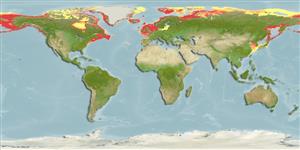Common names from other countries
Classification / Names / Names
Nombres comunes | Sinónimos | Catalog of Fishes (gen., sp.) | ITIS | CoL | WoRMS
Environment: milieu / climate zone / depth range / distribution range
Ecología
; rango de profundidad 0 - 200 m (Ref. 1603). Temperate
Distribución
Países | Áreas FAO | Ecosistemas | Ocurrencias, apariciones | Introducciones
Northeast Atlantic, Northern Pacific, and the Arctic: Bering Sea and Chukchi Sea.
Length at first maturity / Tamaño / Peso / Age
Maturity: Lm ? range ? - ? cm Max length : 14.0 cm TL macho / no sexado; (Ref. 1603)
Unattached and partly imbedded in sand or mud; from shallow water down to depths of 200 meters (Ref. 1603).
Life cycle and mating behavior
Madurez | Reproducción | Puesta | Huevos | Fecundidad | Larva
Members of the class Ascidiacea are hermaphroditic; both cross- and self-fertilization is typical. Life cycle: Eggs develop into lecithotrophic larva before metamorphosing into benthic adults.
Jagerskiold, L.A. 1971. (Ref. 1369)
IUCN Red List Status (Ref. 130435)
CITES status (Ref. 108899)
Not Evaluated
Not Evaluated
Human uses
| FishSource |
Herramientas
Más información
Age/Size
Crecimiento
Length-weight
Length-length
Morfología
Larva
Abundancia
Fuentes de Internet
Estimates based on models
Preferred temperature
(Ref.
115969): 0.1 - 10.5, mean 2.8 (based on 1813 cells).
Vulnerability
Low vulnerability (10 of 100).
Price category
Unknown.
